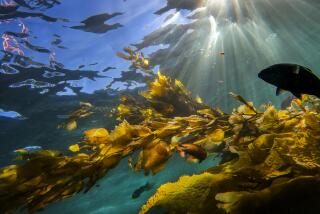Water World : Inner Workings : Science File / An exploration of issues and trends affecting science, medicine and the environment.
The study of oceanic processes is vital to climate change research because oceans cover 70% of the planet the ant and contribute to global het transport and global heat transport and global meteorological phenomena such as El Nino. In addition, oceans play an important role in regulating the amount of greenhouse gases , such as carbon dioxide, in the atmosphere. Remote sensing of oceans provides global information on sea surface temperature, ocean color, winds and surface topography. Here are examples of how satellite observation and computerized models improve understanding of the role of oceans in the Earth’s climate systems.
Winds Over the Pacific
Winds drive water over Earth’s surface and influence the exchange of heat between the atmosphere and oceans. In this map, wind speed is shown by blue and purple for lighter winds and yellow and orange for higher winds.
Ocean Surface Topography
The maximum sea level is located in the western Pacific (white) and the minimum is shown around Antarctica (blue and purple). In the Northern Hemisphere, ocean currents flow clockwise around the highs of ocean topography and counterclockwise around the lows. This pattern is reversed in the Southern Hemisphere. These highs and lows are the oceanic counterparts of atmospheric circulation systems and can be considered the “climate” of the ocean. The existence and basic structure of the ocean systems are constant, but the details of these systems are always changing.
Phytoplankton
Phytoplankton, microscopic plants near the surface of the ocean, play an important role in the global carbon cycle through photosynthesis. The global pattern of phytoplankton shows a high concentration (red and yellow) at high latitudes in the Northern Hemisphere, a relatively low concentration in the Southern Hemisphere, and a very low concentration (purple and blue) in middle latitudes.
Temperatures
Satellites measure sea surface temperature, with warmest areas indicated by red tones, coolest by dark blue.
Abnormal variations in the sea surface temperature occurred during the December, 1982, El Nino mapped here. Warmer-than-normal water rages from pink to orange, while unusually cool water appears as gray to blue.
Variations in ocean temperatures along the U.S.S East Coat are shown from warmest (red) to coolest (blues and violets). Red and yellow swirls are eddies in the Gulf Stream.
Sources: TOPEX/Poseidon, Jet Propulsion Laboratory, Goddard Space Flight Center, Advanced Very High Resolution Radiometer, via NASA EOS Project Science Office.






